In Baseball Prospectus’ transaction analysis about Bartolo Colón’s re-signing with the Mets from December, R.J. Anderson wrote that the Mets kept Colón because they “needed someone to fill out their rotation.” After all, the Mets traded Jon Niese away, and they’d have to wait until mid-season for Zack Wheeler to join the rotation. It was sound analysis at the time.
But things happening after the fact have a way of making any insightful analysis look off. The Mets were forced to fill even more rotation holes after losing Matt Harvey for the season, and they went back to the Jon Niese well. Wheeler won’t see a major-league mound this season. In hindsight, bringing back Colón was a great move, and it’s not just because he’s adequately filled a hole in the rotation for much longer than originally anticipated. His spot is entrenched, and he’s put up his best season as a member of the Mets that demand questions about 2017.
Colin’s surface results have far surpassed anything else he’s done in Mets colors. In his first two seasons with New York, Colón posted a 4.13 ERA in 397 total innings pitched. He didn’t strike out a lot of batters–6.5 per nine for those two seasons–but he also didn’t walk many, just 1.2 per nine innings. Still, every adjusted metric, from Baseball Prospectus’ DRA-, to Baseball Reference’s ERA+, to FanGraphs’ ERA-, suggested that Colón was performing below the league average. He was, indeed, someone who could be expected to be adequate. He’s been more than that. In 2016, Colón’s ERA has fallen almost a full run, to 3.14. While Noah Syndergaard has been at another level, Colón has proven to be just as valuable as Jacob deGrom and Steven Matz.
But Colón is walking a tightrope. The results have been different, but he’s been essentially the same pitcher in 2016 as he was during his first two seasons with the Mets. He’s experienced small changes. Colón has struck out 5.88 batters per nine innings and walked 1.62. Those figures are slightly worse than his first two seasons with the Mets, but they both contribute to a higher FIP. Still, that FIP is just 3.96. Colón’s improved ERA might be explained by his strand rate. In 2016, it’s 78.2 percent compared to the 70.2 and 71.9 percent strand rates he had in 2014 and 2015, respectively. Colón’s been better on the surface, and he’s done far more than fill a gap in the rotation. Still, with the emergence of Robert Gsellman, he’ll probably still end up the third starter if the Mets make it to the Division Series.
The fun part in all of this, of course, is that Colón’s doing this at the age of 43. He’s a better, right-handed, version of the extremely-close-to-washed-up and near the end of his career 35-year-old Jorge De La Rosa. Colón is having one of the 16 best age-43 seasons for a starter in the history of baseball—there have only been 16 recorded, ranging from Cy Young’s in 1910 to Colón’s this season. In five of those 16 seasons, the pitcher in question threw fewer than 100 innings. Colón has thrown 177.2. As noted, his results have been better this season, even though his underlying statistics aren’t trending in the right direction.
It’s strange to think of where numbers are “trending” for a 43-year-old, unless it’s about retirement savings, but that leads to the final question. Colón 2017 would probably look more like the 2014-2015 version than 2016. The underlying numbers suggest his 2016 ERA would be difficult to repeat. The 2014-2015 version wasn’t bad though. If Colón is ready and willing, would it be a good idea for the Mets to bring him back?
Even now, the Mets’ rotation going into 2017 looks like it will be more crowded than it was in 2016. Syndergaard, Matz, and deGrom, and Gsellman should all be locks for the rotation. Harvey should return, and after sitting out all of 2016 recovering from Tommy John surgery, Wheeler really should come back. Colón could find himself seventh on the depth chart. But, as happens, things tend to turn out differently than one expects. What if those bone spurs continue to bark or lead to something worse (yes, I knocked on wood)? What if Harvey returns, but the Mets get the bad version that we saw in 2016? What if Gsellman isn’t quite what he’s seemed to be? If any of those things happen, the Mets might be lucky to have Colón at the ready to throw fastballs and consume innings.
But that’s not to assume that Colón doesn’t come with risk as well,. He is, after all, (relatively) old. His downward aging curve could come all at once. There’s also a romantic reason to be skeptical of a return. Colón has been so much fun to watch. The way he plays catch with himself during dead time says “I’m having fun out here.” He also hit a home run! It would be a little dispiriting to have Colón’s sendoff be a June DFA due to ineffectiveness. Ultimately, what he’s done this year just might be Bartolo Colón’s perfect sunset season.
Photo credit: Mark J. Rebilas-USA TODAY Sports
